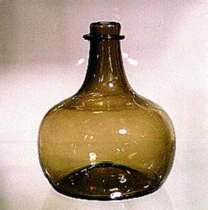|
BOTTLE SIZES
WINE BOTTLES
Half Bottle = 375 ml
Normal Bottle = 750 ml
Magnum = 2 bottles
Marie-Jean = 3 bottles
Double Magnum = 4 bottles
Jeroboam = 6 bottles
Imperiale = 8 bottles
CHAMPAGNE BOTTLES
Split = 1/4 bottle
Bottle = 750 ml + 3 cl
Magnum = 2 bottles
Marie-Jeane = 3 bottles
Jeroboam = 4 bottles
Reboboam = 6 bottles
Methuselah = 8 bottles
Salmanazar = 12 bottles
Balthazar = 16 bottles
Nebuchadnezzar = 20 bottles
|
|
99 bottles of wine on the wall...
a primer on wine bottles
By: Thomas M. Ciesla
Originally published in texaswinetrails.com; March, 2001.
Article has been reformatted for online publishing
|
|
Did
you know that each year well over a billion wine bottles are made around the world? Gallo Glass alone (a sudsidiary of Gallo Wines) produces 2 million wine bottles -- A DAY! In 1999, Australian bottle makers produced 700 million wine bottles and expansion plans are underway to produce 1.4 billion by 2005. Most of us fail to appreciate the impact of the lowly glass wine bottle on our lives. Oh sure, we fumble with them, curse them, strain our backs carrying cases of them, break them, fill our trash with them, and even invent ritualistic behaviors for using them. But why are they shaped the way they are? Let's take a look......
|
|
A bottle by any other shape....

An Old Style Wine Bottle |
For the next few hundred years wine bottle shapes tended to be short and fat as shown in the photo on the right. Things began to change in 1635 when Sir Kenelam Digby invented the first thick-walled wine bottle, though these were square decanters with short necks. During the 1700's the wine bottle evolved into the long flat cylinder that we know today, and the invention of first bottle making machines in the 1800's meant that for the first time, bottles could be made with consistency in size and shape.
This shape allowed bottles to be stored horizontally, thereby keeping the cork moist thereby assuring a good seal. Now wine could be stored for long periods without spoilage. Indeed, winemakers found that their wines could actually improve in these bottles, often colored anywhere from a pale green to a dark green that is almost black.
|
|


Burgundy and Bordeaux
bottle styles
|
THE SHAPES WE LOVE
American wineries have no rules about bottle shapes, so anything can be used.
Today, the standard wine bottle is 750 ml, established by the United States in the late 1970s as we planned to 'go-metric'! Most other countries have adopted that standard to be able to sell wine in the States. The shape of wine bottles varies considerably, but a handful of shapes dominate the marketplace. Most of us are familiar with the two bottles styles shown on the left: "slope-shouldered", Burgundy-style and the "square-shouldered", Bordeaux-style (sometimes called Claret style). The Burgundy style is said to be the older, being one of the first shapes that glass-blowers could master. Later, someone in Bordeaux came up with the other style, in part to look different from the competition, but more to provide a way to trap sediment in the bottle when the wine was being poured.
|
|
The Burgundy bottle with its shallow, gentle sloping shoulders, is made in a green glass for both red and white wines, and occassionally in clear glass. This shape is typically used for Chardonnay, Pinot Noir and other Rhone varietals. Why Pinot Noir, a red wine, in this style bottle? Because Pinot Noir is classified as a Burgundy (region) grape.
The Bordeaux bottle with straight sides and steep, tall, shoulders is typically made with dark green glass for the red wines, light green glass for the white wines and clear for the dessert wines. Probably the most common shape used for red wine around the world, ranging from the classic 'Bordeaux grapes: Cabernet and Merlot,as well as other wines such as Zinfandel and Syrah. It is also used for white wine such as Sauvignon Blanc.
|

 
Champagne, Port , and Alsace
bottle styles
|
Other Dominant Shapes
The first is the Champagne bottle, a design born out of necessity. The thick walls, long neck and large punt are required to withstand the higher pressures (up to 90 psi) found with Champagne. Next is the fortified wine bottle, typically used for. Port, Madeira and Sherry. The bulb in the neck is to help capture sediment while decanted. Finally, we have the Alsace and Mosel bottle . A narrow, thin tall bottle with a very gentle sloping shoulder, used for wines such as Riesling, Gewurtztraminer and Pinot
|
|